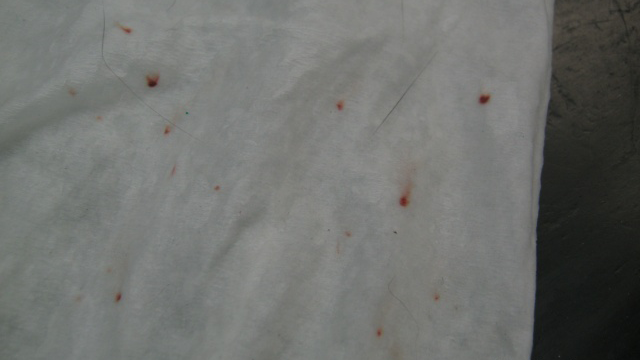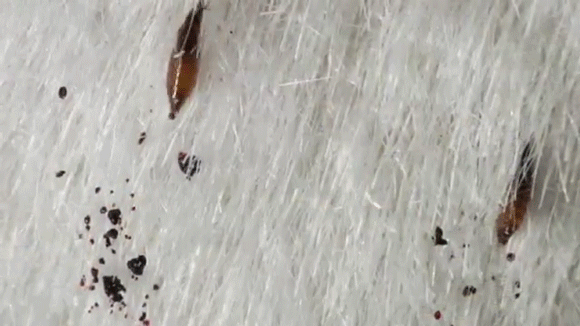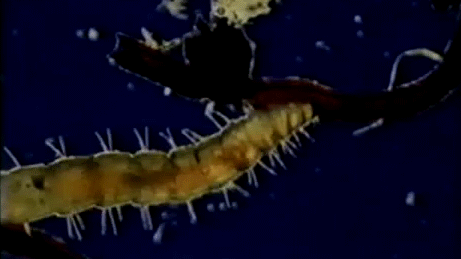
Img 1 Flea dirt is feces, appearing as dark red or black specks in a cat’s fur.
Summary
Flea dirt is the common name for flea poop. It’s the feces from adult fleas, and is largely composed of undigested host blood. The fecal blood dries and breaks apart into reddish-black specks in a pet’s fur. Eventually it falls from the animal during grooming and lands in the environment where it’s consumed by larvae.
Details
What Flea Dirt Looks Like
General Description
Adult fleas defecate onto their hosts. When the excreta dries, it breaks apart into irregular-shaped, dark red or black specks Img 1. Flea dirt (also called flea frass) looks like black pepper or black dandruff. It’s also been described as reddish-brown debris.
Spherules & Coils
Flea excrete feces in two different forms: Spherules and coils. Spherules are round and 0.07-0.25 mm in size. Coils are long with an average length of 0.84 mm Img 4. Newly emerged adults produce spherules. By the tenth day of feeding, their poop is mostly in the form of coils.
Identification
Finding flea dirt on a dog or cat is one of the best ways to diagnose an infestation. If it’s truly flea feces, the black speck will smear red when rubbed on a wet paper towel. The crimson color results from reconstituted blood Img 2. A dampened cloth can also be rubbed on a dog’s or cat’s fur. Flea dirt will stick the cloth and smear red. Similarly, placing flea dirt into a drop of water will cause the water to turn red.

Img 2 A wet paper towel with flea dirt recovered from a cat. The red smears are caused from the reconstituted blood.
Blood Digestion & Excretion
Adult fleas imbibe much more blood than they can use. Thus, large amounts of feces are produced while feeding. It consists of partially digested or undigested host blood.

Img 3 A cat flea feeding off a host and excreting undigested fecal blood. The feces falls off the host and into the environment. It’s primary food source of larvae.
When a flea feeds, blood flows into its sac-like midgut. There, blood-digesting enzymes are released. However, only the blood closest to functional midcut cells is retained for digestion, because it moves rapidly through the gut. Most isn’t digested. After passing through the midgut, the blood enters into a short hind-gut which ultimately ends at the anus.
Host blood is digested more completely by other parasites, such as mosquitoes and bedbugs, than it is by fleas. This makes sense, as larvae of these insects don’t consume adult feces, while flea larvae do.
Amount of Flea Dirt Produced Daily
Gut Capacity & Blood Consumption
Cat flea guts hold around 5 µl of blood. But they ingest an average 6.97 µl of blood per day. And reproducing females can imbibe 13.6 µl of blood daily, an amount equal to over 15 times their body weight.
Feces Amount
Fleas feed at random, for 2-3 minutes at a time. 8-10 droplets of feces are excreted at each feeding. The average adult flea expels 0.645-0.770 mg of feces per day. Both genders excrete protein-rich flea dirt, but females produce a greater volume. They expel around 17 times as much feces as males (0.8546 vs 0.0503 mg daily).
Why Fleas Consume Excess Blood
Low Energy Costs
Cat fleas are vessel (capillary) feeders, as opposed to pool feeders. Vessel feeding facilitates a rapid meal, because the host’s blood pressure gets exploited. Flea mouth-parts are highly adapted for piercing and sucking, and, along with anticoagulant saliva, blood flows easily into their guts. Once a flea bites, imbibing excess blood has few energy costs.
Parental Care
Flea dirt is the primary food source for larvae. It gives them their minimal nutritional requirements. They won’t reach adulthood without it. The feces provides larvae with the iron and protein needed for normal growth and sclerotisation.
Flea dirt contains 83-90% of the original blood’s protein, as well as 44-80% of the potassium and chloride ions. Coils contain 33% more protein than spherules. The spherules are thought to be preferred by young larvae, while the protein-rich coils are more suitable for 3rd instars.

Img 4 Cat flea larva feeding on a coil of fecal blood. See Img 1 for what a spherule looks like.
Adult fleas may purposely ingest excess blood to feed larvae, or they may be harvesting out key nutrients, such as vitamin B, for themselves. Whatever the reason, the larvae greatly benefit in the end. Even if the feces falls out of range of larvae, it could still be used by future generations. It appears to be an evolutionary step towards parental care. Females make larger parental investments than males, indicated by their significantly higher production of feces.
Where Flea Dirt is Found
Fleas Defecate on Hosts
Adult cat fleas are permanent residents of their hosts. They’ll rarely leave of their own choosing. As a result, they feed and defecate directly on animals. The flea feces dries rapidly.
Flea Dirt Falls when Hosts Groom
Flea dirt dries in irregular shapes and gets embedded into pet fur. However, it doesn’t stay there. The dry blood dislodges when animals scratch and groom themselves. As a result, it’s most common to find feces (and eggs) in areas where pets commonly rest and groom. Most flea dirt falls off into the environment, but some will remain in the animal’s haircoat.




You must log in to post a comment. Log in now.